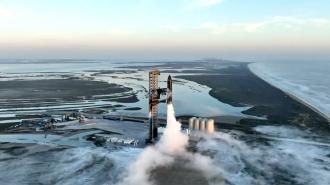SpaceX first attempted to fly Starship — the world’s biggest rocket — in April, but an anomaly soon after launch forced SpaceX to end the test early (and in spectacular fashion) by detonating the rocket over the Gulf of Mexico.
On Saturday, November 18, the company gave it another shot, and this time, the rocket made it all the way to space — before SpaceX had to blow it up.
The details: Starship lifted off from its launch tower at Starbase in Texas just after 8 am ET. The biggest test of the rocket came a few minutes later, when SpaceX “hot fired” it for the first time, igniting its upper stage engines before attempting to separate the two stages.
The separation was a success — a major milestone, given that this was the point of failure during the first Starship launch attempt — but SpaceX wasn’t able to recover the lower stage booster as planned.
The upper stage continued ascending, but around the time it reached an altitude of 91 miles — officially putting it in space — SpaceX lost contact with the rocket.
“We think we may have lost the second stage… What we do believe right now is that the automated flight termination system on the second stage appears to have triggered very late in the burn,” said SpaceX engineer John Insprucker about 12 minutes post-launch.
Looking ahead: NASA plans to use Starship to return people to the moon as soon as 2026, and Musk recently said he thinks the rocket could be ready for uncrewed trips to Mars as soon as 2027 — the first step toward his ultimate goal of using it to colonize the Red Planet.
SpaceX plans to fly several more uncrewed Starships before putting people on board, and with each test, it’ll hopefully get one step closer to a complete success — and one step closer to using the rocket to send people farther into space than they’ve ever gone before.
We’d love to hear from you! If you have a comment about this article or if you have a tip for a future Freethink story, please email us at tips@freethink.com.
